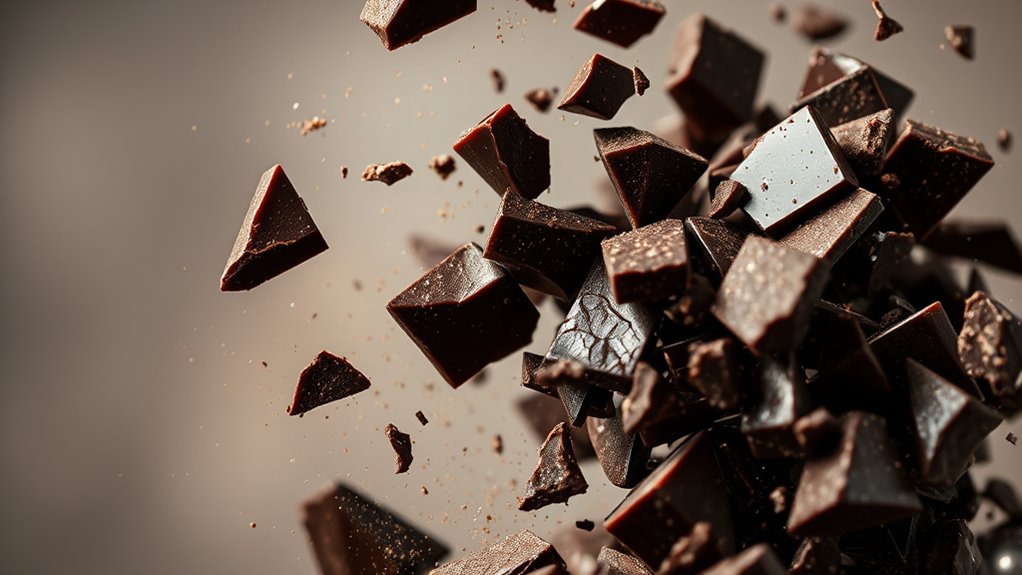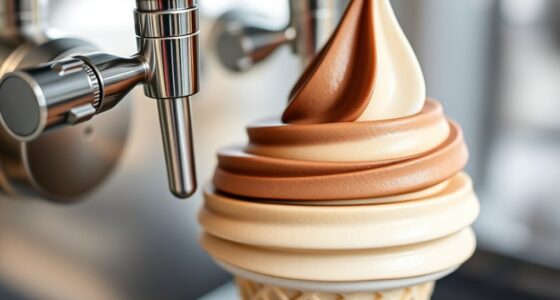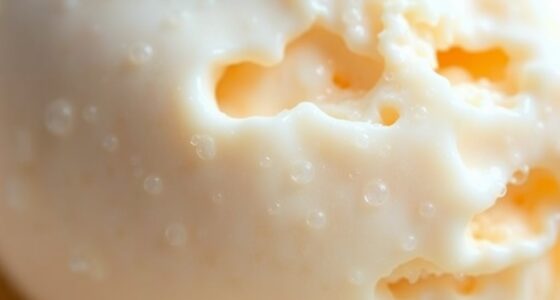To make chocolate shatter into flakes in stracciatella, you need to control the chocolate’s temperature and viscosity precisely. You melt and temper the chocolate to a consistency that’s fluid enough to pour but thick enough to hold shape. When you pour it into the cold ice cream, rapid cooling causes the chocolate to harden quickly and crack into irregular flakes. Mastering this balance guarantees perfect flakes, and if you keep exploring, you’ll discover how technique influences each delicate fragment.
Key Takeaways
- Proper chocolate viscosity allows it to break into flakes rather than pooling or forming puddles.
- Rapid cooling of melted chocolate upon contact with cold ice cream causes it to harden into irregular shards.
- Precise temperature control ensures chocolate is firm enough to crack but not melt completely during application.
- Timing the pouring process is critical; too early or late affects flake size and formation.
- The interplay of cooled ice cream and chocolate’s viscosity creates the characteristic delicate flakes of stracciatella.

Stracciatella mechanics refers to the unique process behind creating the iconic Italian ice cream flavor that features irregular chocolate shreds suspended throughout a creamy base. If you’ve ever enjoyed a bowl of stracciatella, you might wonder how those delicate flakes form so perfectly within the ice cream. The secret lies in understanding how ice crystal formation and chocolate viscosity work together during the freezing process.
When making stracciatella, you start with a rich, smooth ice cream base that’s cooled to just above freezing. At this stage, the key is controlling ice crystal formation. As the mixture cools, tiny ice crystals start to develop, giving the ice cream its signature creamy texture. However, the process isn’t just about freezing; it’s about how the chocolate interacts with the cold environment. If the chocolate is too warm or too viscous, it won’t shatter properly into flakes. Instead, it may melt or form uneven patches. That’s why achieving the right chocolate viscosity is critical.
The chocolate used in stracciatella is carefully tempered to reach a specific viscosity—thick enough to hold its shape but fluid enough to be poured in a thin stream. When you pour or drizzle the melted chocolate into the semi-frozen ice cream, it quickly cools and hardens on contact. Because of the low temperature, the chocolate doesn’t melt into a uniform coating; instead, it solidifies into irregular flakes. As the mixture continues to freeze, these flakes become embedded within the ice cream, creating that characteristic stracciatella look.
The rapid cooling of the chocolate is essential. If it cools too slowly, it won’t shatter into flakes but will instead form larger chunks or puddles. The goal is to have the chocolate cool and set just enough to crack into fragments when stirred or scooped. The irregularity of these flakes is what gives stracciatella its distinctive texture and visual appeal. This process relies heavily on precise temperature control and timing, ensuring the chocolate doesn’t overheat or overcool before hitting the ice cream.
Additionally, understanding the role of viscosity in chocolate is vital for achieving the perfect flakes, as it directly influences how smoothly the chocolate will shatter upon contact with the cold ice cream. In essence, the art of stracciatella mechanics is about balancing ice crystal formation in the ice cream with the right viscosity of chocolate, so it shatters into delicate flakes rather than melting or forming uneven patches. When done correctly, this delicate dance results in a luxurious, textured treat that’s both visually appealing and delicious to eat. Your understanding of these mechanics helps you appreciate the craftsmanship behind every scoop of stracciatella.
Frequently Asked Questions
How Does Temperature Influence Chocolate Shattering?
Temperature control plays a vital role in how chocolate shatters. If you expose it to rapid temperature changes, like sudden cooling or heating, thermal shock occurs, causing the chocolate to break into flakes. To achieve perfect shattering, you need to carefully manage the temperature, ensuring gradual cooling or heating. This prevents unwanted cracks and helps the chocolate shatter into delicate flakes, enhancing texture and appearance.
What Types of Chocolate Are Best for Stracciatella?
You should choose temperate dark or milk chocolates for stracciatella, as their balanced flavor profiles enhance the texture and taste. Dark chocolate offers a rich, intense flavor, while milk chocolate provides a sweeter, creamier experience. Both types shatter into appealing flakes when broken, creating that delightful contrast in your dessert. Opt for high-quality chocolates with cocoa content around 60-70% to guarantee ideal flavor and proper shattering.
Can Stracciatella Techniques Be Used With Other Confections?
Yes, you can definitely use stracciatella techniques with other confections. By incorporating chocolate infusion into your creations, you add a delightful texture and flavor pairing that enhances the overall experience. When you break the chocolate into flakes, it creates a crunchy contrast, perfect for toppings or fillings. Experimenting with different confections allows you to explore new textures and flavor combinations, elevating your desserts in unique and delicious ways.
How Does Chocolate Composition Affect Flake Formation?
You’ll be amazed how chocolate’s composition transforms into spectacular flakes! The crystal structure, influenced by temperature and cooling, determines how easily it shatters. Higher fat content creates softer, more flexible flakes, while lower fat makes them crisper and more brittle. When you understand these factors, you control the flake formation process, turning ordinary chocolate into a mesmerizing display of delicate, shattering flakes that wow everyone.
What Tools Are Essential for Achieving Perfect Shattering?
To achieve perfect shattering, you need precise tools like a thermometer for accurate tempering techniques and a stable work surface. Properly controlling chocolate viscosity during tempering ensures the chocolate’s crystalline structure is ideal for flakes. Use a scraper or spatula to handle the chocolate smoothly, and work quickly to maintain ideal temperature. These tools, combined with careful tempering, help you produce crisp, beautiful flakes every time.
Conclusion
Now that you understand how stracciatella’s chocolate shatters into delicate flakes, you can appreciate its magic in every scoop. It’s like watching a secret spell unfold, where heat and cold dance together—no wizardry needed. So next time you indulge, remember: even in a world without smartphones, this simple process creates pure bliss. Embrace the artistry behind each bite, and let the timeless charm of stracciatella remind you that sometimes, tradition is the sweetest secret.










